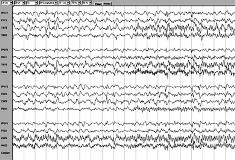MIGRATING PARTIAL SEIZURES IN INFANCY: SIX NEW CASES
Abstract number :
2.119
Submission category :
Year :
2002
Submission ID :
3579
Source :
www.aesnet.org
Presentation date :
12/7/2002 12:00:00 AM
Published date :
Dec 1, 2002, 06:00 AM
Authors :
Andrew J. Kim, Darryl C. De Vivo, Carmela L. Tardo, Douglas R. Nordli, Jr.. Neurology, Children[ssquote]s Memorial Hospital, Chicago, IL; Neurology, Columbia University, New York, NY; Neurology, Louisiana State University, New Orleans, LA
RATIONALE: At the end of this activity, the participants should be able to discuss the clinical and EEG characteristics of patients with Migrating partial seizures of infancy.
In 1995 Coppola et. al. ([italic]Epilepsia[/italic] 36:1017-1024) described 14 epileptic infants with unidentified cause whose clinical and EEG features were similar to each other but dissimilar from any of the previously described epilepsy syndromes. They named this newly categorized disorder Migrating partial seizures in infancy (MPSI). Only seven additional cases of MPSI have since been reported in literature. We present six additional patients who fit the diagnostic criteria for MPSI and further substantiate MPSI as a distinct and recognized infantile epilepsy syndrome.
METHODS: Six patients who fulfill the diagnostic criteria for MPSI [ndash] as defined by Coppola et. al. [ndash] were identified through retrospective chart review of the patients evaluated at three tertiary care epilepsy centers between 1993 and 2001. The CCTV/EEG data of the six patients were also analyzed. The clinical and EEG features of these patients were described in detail, and representative segments of the EEG were shown (see below).
RESULTS: Our six patients resembled the previously described cases of MPSI via the diagnostic criteria: (1) seizure onset at less than 6 months of age, (2) nearly continuous multifocal partial seizures, (3) seizures intractable to standard anticonvulsants, (4) absence of identifiable etiology, (5) rhythmic alpha or theta ictal EEG pattern, and (6) psychomotor arrest or regression after the seizure onset. Our six patients also served to highlight the variable features of this condition. Two of our six patients developed infantile spasms, thereby showing definitively that MPSI can occur with or without co-morbid spasms. Two of our patients were siblings, representing the first described familial cases of MPSI. The familial cases imply that both hereditary and nonhereditary etiologies probably underlie MPSI.
CONCLUSIONS: MPSI is a globally occurring epilepsy syndrome. To account for the variations in prognosis, co-morbidity, and familial predisposition, we hypothesize that MPSI represents an uncommon expression of an age-dependent epileptic encephalopathy. As with other age-dependent epileptic encephalopathies, MPSI[ssquote]s variable features are ascribed to the multiplicity of underlying etiologies. The common features of MPSI are ascribed to the nonspecific effects of seizures on a specific neurophysiological substrate at a specific stage of CNS development.[figure1]
